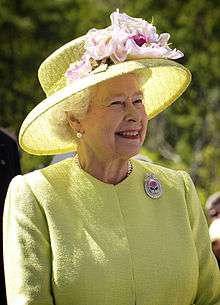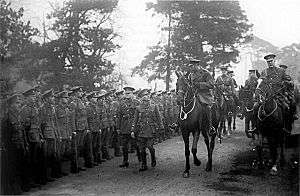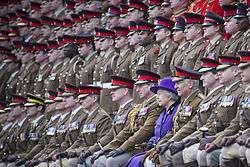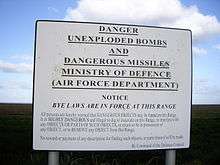Commander-in-chief of the British Armed Forces
The commander-in-chief of the British Armed Forces, also referred to as commander in chief of the armed forces of the Crown, is a milatary office vested in the British monarch, currently Queen Elizabeth II, who by Virtue of the throne is the "Head of the Armed Forces".[1][2] Under British constitutional law the command and government of the British armed forces is vested in the Queen and as such she holds the highest office in the military chain of command.[3] The authority to issue orders and give commands to military personnel is delegated by the Queen to her commanders in the Field, however she does retain the right to issue orders personally. Before joining the military all recruits of the British Armed Forces must take the following oath:
I... swear by Almighty God (do solemnly, and truly declare and affirm) that I will be faithful and bear true allegiance to Her Majesty Queen Elizabeth II, Her Heirs and Successors, and that I will, as in duty bound, honestly and faithfully defend Her Majesty, Her Heirs and Successors, in Person, Crown and Dignity against all enemies, and will observe and obey all orders of Her Majesty, Her Heirs and Successors, and of the Generals and officers set over me.

Long-standing constitutional convention, however, has vested de facto executive authority, by the exercise of Royal Prerogative, in the Prime Minister and Her Majesty’s Secretary of State for Defence. The Prime Minister (acting with the Cabinet) makes the key decisions on the use of the armed forces.[4][5] The Queen however, remains the supreme authority of the military.[6]
Defence Services Secretary of the Royal Household
The Defense Services Secretary is an officer of the royal household. He is the primary channel of communications between the monarch, in her capacity as commander-in-chief of the Armed Forces, and the officers and commands of the British Armed Forces. His office provides the Monarch with the information and documentation related to defense affairs that she requires to perform her military functions. The Defense Services Secretary is responsible to the Queen, The Secretary of State for Defense and the Chief of the Defense Staff for tri-service military appointments. He submits the names of the officers nominated for promotion to the queen through her private secretary.
Military appointments
As supreme commander, the queen makes appointments to a large number of military offices:
- The Chief of the Defense Staff ( General )
- The First Sea Lord and Chief of the Naval staff ( Admiral )
- Navy Commander Operations ( Rear Admiral )
- Navy Fleet Commander ( Vice Admiral )
- Commander United Kingdom Strike Force ( Rear Admiral )
- Comandant General Royal Marines ( Major General )
- The Chief of the Air Staff (Air chief Marshall )
- The Chief of the General Staff ( General )
- Deputy Chief of the General Staff ( Lieutenant General )
- Defense Services Secretary ( Rear Admiral )
- Military (Army) Secretary ( Major General )
- Naval Secretary ( Rear Admiral )
- Air Secretary
- Commander Strategic Command ( General )
- Commander Field Army
- Major General Commanding the Household Division ( Major General )
- Commander Joint Helicopter Command
The queen makes appointments to the following ranks directly:
- Field Marshal
- Air Chief Marshal
- General
- Lieutenant General
- Major General
Appointments to lesser ranks are delegated by Her Majesty. A new constitutional convention appears to have become enshrined since 2003, whereby the UK will only take military action (other than in circumstances of having to immediately react to threats to its national security) with the consent of the House of Commons. Ultimately however, The Queen can still command such at will. Officers and the other personnel of the military and the territorial police forces also swear allegiance only to the sovereign and their successors, and not government – this ensures that all ministers (in particular the Prime Minister) can be held accountable, and are therefore not 'above the law', unlike the monarch.
The Crown and government
The Ministry of Defence is the highest level military headquarters charged with formulating and executing defence policy for the Armed Forces; it employed 57,000 civilians in October 2017.[7] The department is controlled by the Secretary of State for Defence (or "the Defence Secretary"); and is assisted in his duties by four junior ministerial appointments: Minister of State for the Armed Forces, Minister for Defence Procurement, Minister for Defence People and Veterans, and a Minister of State in the House of Lords.
Responsibility for the management of the armed forces is delegated to a number of committees: the Defence Council and its three single-service boards, the Defence Board [8] and the Chiefs of Staffs Committee . The Defence Council, composed of senior representatives of the services and the Ministry of Defence, provides the "formal legal basis for the conduct of defence" and is chaired by the Defence Secretary.[9][10] The three constituent single-service committees (Admiralty Board, Army Board, and Air Force Board) are also chaired by the Defence Secretary.
The Chief of the Defence Staff (CDS) is the professional head of the British Armed Forces and is an appointment (held by an Admiral, General or Air Chief Marshal) made by the sovereign, on the advice of the Prime Minister and the Defence Secretary. Furthermore, CDS is the principal military adviser to the Defence Secretary, and the Prime Minister chaired National Security Council. In addition, CDS, along with the Permanent Under Secretary, are the principal advisers to the Defence Secretary. The three armed services have their own respective professional chiefs; the First Sea Lord who is also Chief of Naval Staff, the Chief of the General Staff and the Chief of the Air Staff. All three service chiefs have direct right of access to the Prime Minister.
Historic office of Commander-in-Chief
From 1660 until 1904 the professional head of the Army was known as the Commander-in-Chief and as such had significant independence and power. Under the Commonwealth Government, the Commander-in-chief was a de facto head of state.
Naval, Military and Air commands
Until 2012 each of the three services also had one or more commands with a (four-star) commander-in-chief in charge of operations. These were, latterly: Commander-in-Chief Fleet (CINCFLEET – sharing a Command HQ with Commander-in-Chief Naval Home Command (CINCNAVHOME)), Commander-in-Chief, Land Forces (CINCLAND) and Commander-in-Chief Air (CINCAIR). (At one time there were many more Naval, Military and Air Commands, each with (in many cases) their own Commanders-in-Chief.)
Since 2012, however, full operational command has been vested in the three Chiefs of Staff, and the appointment of distinct Commanders-in-Chief has been discontinued. This change was implemented in response to the 2011 Levene report, which advised that it would serve to "streamline top-level decision-making, simplify lines of accountability... remove duplication between the posts and also provide impetus to the leaning of the senior leadership".[11] New three-star appointments (Fleet Commander, Commander Land Forces) mirror the old ones, but these are subordinate officers with delegated command responsibility, rather than commanders-in-chief. Command runs from the Ministry of Defence to the Permanent Joint Headquarters which executes operations, excluding NATO-led operations.
 King George II at the Battle of Dettingen in 1743, by John Wootton. It remains the last time a British monarch personally led his troops into battle.
King George II at the Battle of Dettingen in 1743, by John Wootton. It remains the last time a British monarch personally led his troops into battle. King George V inspecting the British 29th Division prior to the division's departure for Gallipoli in 1915. The division commander, Major General Aylmer Hunter-Weston, rides alongside the King at the right of the photo.
King George V inspecting the British 29th Division prior to the division's departure for Gallipoli in 1915. The division commander, Major General Aylmer Hunter-Weston, rides alongside the King at the right of the photo. Queen Elizabeth II posing for a photograph with soldiers from the Household Cavalry, at Combermere Barracks in 2012.
Queen Elizabeth II posing for a photograph with soldiers from the Household Cavalry, at Combermere Barracks in 2012. A warning sign posted "By Command of the Defence Council".
A warning sign posted "By Command of the Defence Council".
Commander in chief of Bermuda
In the colonies of the English Empire, and subsequently the British Empire, the duties of lords-lieutenant were generally performed by the commander-in-chief or the governor. Both offices may have been occupied by the same person.
By way of an example, this is still the case in Britain's second, and oldest remaining colony Bermuda, where the Royal Navy's headquarters, main base, and dockyard for the North America and West Indies Station was established following independence of the United States of America. The colony had raised militia and volunteer forces since official settlement in 1612 (with a troop-of-horse added later), and a small force of regular infantry from 1701 to 1783. A large regular army garrison was built up after 1794, and the reserve forces faded away following the conclusion of the American War of 1812 as the local government lost interest in paying for their upkeep. From this point until the 1960s, governors were almost exclusively senior officers of the Royal Artillery or Royal Engineers who were also military commanders-in-chief (and initially also vice admirals).
Attempts to rekindle the militia without a Militia Act or funds from the colonial government were made throughout the century under the authorisation of the governor and commander-in-chief, but none proved lasting. The colonial government was finally compelled to raise militia and volunteer forces (the Bermuda Militia Artillery and the Bermuda Volunteer Rifle Corps by act in the 1890s (the Bermuda Cadet Corps, Bermuda Volunteer Engineers, and Bermuda Militia Infantry were added at later dates), and these fell under the governor and commander-in-chief, as well as under operational control of his junior, the brigadier in charge of the Bermuda Command (or Bermuda Garrison, which included the regular as well as the part-time military (as opposed to naval) forces in the colony. Although the Royal Naval and the regular army establishments have been withdrawn from Bermuda, the Governor of Bermuda remains the commander-in-chief (though most recent officeholders have not been career army officers) of the Royal Bermuda Regiment (a 1965 amalgam of the BMA and BVRC, which had both been re-organised in line with the Territorial Army after the First World War).[12][13]
References
- Queen and Armed Forces, royal.gov.uk. Archived 13 April 2015 at the Wayback Machine
- The Royal Prerogative SN/PC/03861, House of Commons of the United Kingdom. Retrieved 12 May 2013.
- The queens regulations for the army, UK.gov. Missing or empty
|title=(help); Missing or empty|url=(help);|access-date=requires|url=(help) - Governance of Britain, July 2007. Retrieved on 12 May 2013.
- Review of the Royal Prerogative Powers: Final Report, Ministry of Justice, October 2009. Retrieved on 12 May 2013.
- "Whose hand is on the button?". BBC. 2 December 2008. Retrieved 14 March 2009.
- "Data" (PDF). 2017. Retrieved 12 November 2019.
- "Our governance". GOV.UK. Retrieved 24 March 2019.
- Defence Organisation, mod.uk
- Defence Council and Chief of the Defence Staff, armedforces.co.uk
- "An independent report into the structure and management of the Ministry of Defence" (PDF).
- travis.smith-simons (3 March 2016). "The Governor of Bermuda". www.gov.bm.
- "The Good Governor. Biographic article on Major General Sir William Reid KCB, FRS, Governor and Commander-in-Chief of Bermuda from 1839 to 1846. The Bermudian magazine". Archived from the original on 14 November 2017. Retrieved 2 September 2018.